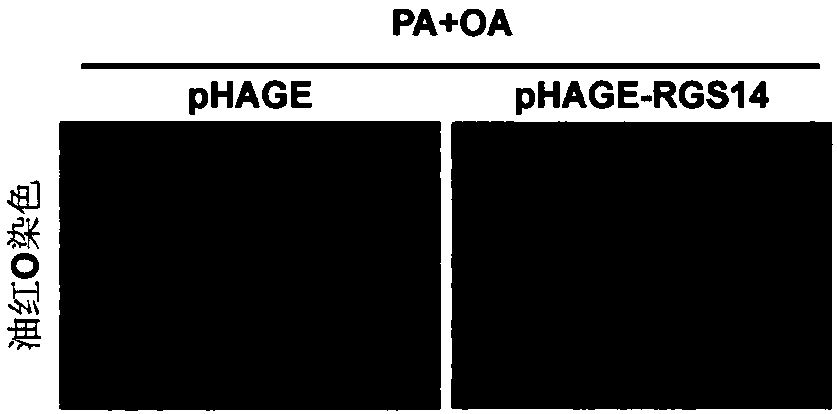Application of protein signal transduction regulatory factor 14 in preparation of drugs for treating fatty liver and related diseases
A technology of signal transduction and regulation factor, which is applied in the field of gene function and application to achieve the effect of high safety
- Summary
- Abstract
- Description
- Claims
- Application Information
AI Technical Summary
Problems solved by technology
Method used
Image
Examples
Embodiment 1
[0086] [Example 1] Effect of overexpression of RGS14 on fat accumulation in liver cells
[0087] Construct a lentiviral expression vector overexpressing RGS14, transfect HEK-293T cells, package lentivirus, infect L02 cells to construct a stable cell line (pHAGE-RGS14) overexpressing RGS14, and overexpress empty vector as a control group (pHAGE group) , Whether the stable cell line highly expresses RGS14 was detected by Western blot; the successfully expressed L02 cell plate was divided into 4 groups, namely the pHAGE control group, the pHAGE-RGS14 control group, the pHAGE experimental group, and the pHAGE-RGS14 experimental group. After the cells adhered to the wall, palmitate (PA, final concentration 0.4mM) and oleic acid (OA, 0.8mM) were added to stimulate the experimental group, while the same amount of BSA was added to the control group, and oil red O staining was performed 16 hours later.
[0088] Western blot detection results such as figure 1 As shown, the protein expr...
PUM
 Login to View More
Login to View More Abstract
Description
Claims
Application Information
 Login to View More
Login to View More - Generate Ideas
- Intellectual Property
- Life Sciences
- Materials
- Tech Scout
- Unparalleled Data Quality
- Higher Quality Content
- 60% Fewer Hallucinations
Browse by: Latest US Patents, China's latest patents, Technical Efficacy Thesaurus, Application Domain, Technology Topic, Popular Technical Reports.
© 2025 PatSnap. All rights reserved.Legal|Privacy policy|Modern Slavery Act Transparency Statement|Sitemap|About US| Contact US: help@patsnap.com


